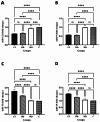Aerobic training and vitamin D modulate hepatic miRNA expression to improve lipid metabolism and insulin resistance in type 2 diabetes
- PMID: 40369056
- PMCID: PMC12078466
- DOI: 10.1038/s41598-025-01757-x
Aerobic training and vitamin D modulate hepatic miRNA expression to improve lipid metabolism and insulin resistance in type 2 diabetes
Abstract
The prevalence of type 2 diabetes mellitus (T2DM) has reached epidemic proportions globally, posing a significant burden on public health. Dysregulation of lipid metabolism and insulin resistance in T2DM often leads to hepatic complications, making the modulation of microRNAs (miRNAs) associated with these pathways a promising therapeutic target. This study aimed to investigate the protective effects of aerobic training (AT) and vitamin D supplementation on the liver of individuals with T2DM by examining the modulation of miRNAs related to lipid metabolism and insulin resistance. Specifically, the miRNAs examined in this study were miR-33, miR-122, miR-29, and miR-9. Thirty-two male Wistar rats with T2DM were randomly assigned to four groups: Control (C), AT, moderate dose of Vitamin D supplementation (MD; 5,000 IU), and high dose of Vitamin D supplementation (HD; 10,000 IU). The AT group underwent an eight-week program consisting of treadmill running sessions, five days per week, with a gradual increase in intensity and duration. The vitamin D supplementation groups received either 5,000 or 10,000 IU of vitamin D, administered via injection once weekly for 8 weeks. The study used the STZ + HFD rat model and collected liver tissue samples for analysis. Total RNA, including miRNA, was extracted from the liver tissue samples, and the miRNA expression levels were quantified using quantitative real-time PCR (qRT-PCR). Statistical analyses were performed using one-way ANOVA followed by Tukey's post hoc test. AT led to significantly lower fasting plasma insulin levels (p < 0.05) and a notable improvement in the homeostatic model assessment of insulin resistance (HOMA-IR) index, indicating enhanced insulin sensitivity compared with the control and other groups. It also resulted in significantly lower triglyceride levels (p < 0.01) and a favorable shift in the HDL/LDL ratio, indicative of improved lipid metabolism. Vitamin D supplementation showed a dose-dependent reduction in insulin resistance, with the 10,000 IU group demonstrating a more pronounced improvement compared with the 5,000 IU group. Rats supplemented with vitamin D exhibited a dose-dependent modulation of lipid profile, with the 10,000 IU group demonstrating a more significant decrease in triglycerides and an increase in HDL/LDL ratio. The expression of miR-33, miR-122, miR-29, and miR-9 differed significantly among the experimental groups. The AT group exhibited a significant downregulation of miR-122 and miR-9 while showing a significant upregulation of miR-33 and miR-29 compared to the C and the MD groups. The HD group showed significant downregulation of miR-122 and miR-9 compared to the C and the MD groups. Both AT and high-dose vitamin D supplementation have beneficial effects on insulin levels, insulin resistance, and lipid metabolism in rats with T2DM by modulating miRNA expression, thereby inhibiting insulin resistance and improving T2DM.
Keywords: Aerobic training; MiRNA modulation; T2DM; Vitamin D supplementation.
© 2025. The Author(s).
Conflict of interest statement
Declarations. Competing interests: The authors declare no competing interests. Ethical approval: All actions performed on the animals followed the guidelines of the Ethics Committee of the Razi University of Kermanshah (IR.RAZI.REC.1401.065 on 2022/11/30) and followed the ARRIVE guidelines. Consent for publication: All the authors have provided their consent for the publication of the manuscript.
Figures


Similar articles
-
Aerobic training with moderate or high doses of vitamin D improve liver enzymes, LXRα and PGC-1α levels in rats with T2DM.Sci Rep. 2024 Mar 17;14(1):6409. doi: 10.1038/s41598-024-57023-z. Sci Rep. 2024. PMID: 38494538 Free PMC article.
-
Vitamin D and exercise improve VEGF-B production and IGF-1 levels in diabetic rats: insights the role of miR-1 suppression.Sci Rep. 2025 Jan 8;15(1):1328. doi: 10.1038/s41598-024-81230-3. Sci Rep. 2025. PMID: 39779732 Free PMC article.
-
Impact of Combined Aerobic Training and Magnesium Supplementation on Serum Biomarkers and microRNA-155 and microRNA-21 Expression in Adipose Tissue of Type 2 Diabetic Rats: An Eight-Week Interventional Study.Biol Trace Elem Res. 2025 Feb;203(2):861-871. doi: 10.1007/s12011-024-04186-5. Epub 2024 Apr 24. Biol Trace Elem Res. 2025. PMID: 38658451
-
Effects of aerobic training and vitamin D supplementation on glycemic indices and adipose tissue gene expression in type 2 diabetic rats.Sci Rep. 2023 Jun 23;13(1):10218. doi: 10.1038/s41598-023-37489-z. Sci Rep. 2023. PMID: 37353689 Free PMC article.
-
Does vitamin C supplementation exert profitable effects on serum lipid profile in patients with type 2 diabetes? A systematic review and dose-response meta-analysis.Pharmacol Res. 2021 Jul;169:105665. doi: 10.1016/j.phrs.2021.105665. Epub 2021 May 11. Pharmacol Res. 2021. PMID: 33984490
References
MeSH terms
Substances
LinkOut - more resources
Full Text Sources
Medical

